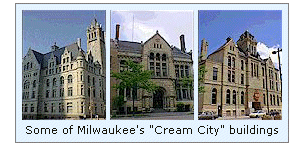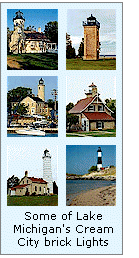|
Milwaukee has long been known as the "Cream City," and while many people assume that the name comes from the State's long pre-eminence in the dairy industry, it is in fact derived from the cream-colored bricks from which many of the City's buildings are constructed. Deep veins of red lacustrine clay run along the western shore of Lake Michigan, and one of the unique properties of this clay is that when formed into bricks, it turns a light golden yellow color after firing. Not only pleasant in color, these bricks generally possess superior strength and weather resistance characteristics, as well as excellent color-retention properties.
Milwaukee's brick making boom lasted well into the 1870's. More and more of the city's buildings were constructed of the local bricks, to a point that visitors could not help but notice the overwhelming cream coloration of the city. As a result, it was during this era that the city became known as the "Cream City," and the bricks in turn became universally known as "Cream City bricks."
While the Cream City brick was known for its durability, as in any industry, some of the local brickyards' output was likely of inferior quality to others. It is also likely that the Lighthouse Depot would have purchased bricks from a number of different brickyards, as bids were accepted for various construction projects. This would explain the reason that some
of the Lights constructed of Cream City brick such as White River and
Eagle Bluff have withstood the ravages of time in extremely good
condition, and stand in their original condition today some one hundred
and twenty years later. Whereas some of the Cream City brick lighthouses began to deteriorate
within a few decades, and required significant rebuilding, such as Cana
Island and Big Sable Point, which both required encasing with steel
plates to protect the deteriorating brick within thirty years of their construction. |
 Milwaukee masons have used these
locally fired bricks since the first brick homes were built in the area
in the late 1830s. By the 1850's, word of Milwaukee's cream-colored
bricks had spread throughout the Midwest, and demand increased
dramatically. To supply that need, brickyards grew throughout the
area, with most of the outbound shipments being made via scows and tugs
leaving the growing docks on the Milwaukee and South Milwaukee
waterfronts.
Milwaukee masons have used these
locally fired bricks since the first brick homes were built in the area
in the late 1830s. By the 1850's, word of Milwaukee's cream-colored
bricks had spread throughout the Midwest, and demand increased
dramatically. To supply that need, brickyards grew throughout the
area, with most of the outbound shipments being made via scows and tugs
leaving the growing docks on the Milwaukee and South Milwaukee
waterfronts. With the Lighthouse Depot in Milwaukee
responsible for the construction of Lake Michigan's remote lighthouses,
it is understandable that construction supplies were purchased locally
and shipped via lighthouse tender to the remote building sites. Thus,
when the Milwaukee Depot's masons were assigned to build a new station,
bricks were purchased from Milwaukee's brickyards, and thus cream city
bricks were used.
With the Lighthouse Depot in Milwaukee
responsible for the construction of Lake Michigan's remote lighthouses,
it is understandable that construction supplies were purchased locally
and shipped via lighthouse tender to the remote building sites. Thus,
when the Milwaukee Depot's masons were assigned to build a new station,
bricks were purchased from Milwaukee's brickyards, and thus cream city
bricks were used.